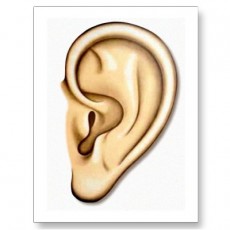Learn to Listen
A million years ago I spent my days designing and studying the creation of sound through the technology of analog and digital synthesizers. My nights were occupied by pushing audio faders and tweaking EQs as a Studio and Live Sound Engineer throughout NYC’s recording studios, clubs and concert venues. Without realizing it I was rewiring the way my brain processed audio signals. I was no longer hearing sound as a simple single source. Instead each “simple” sound possessed dozens of sonic elements, all combining to create a “simple” sound. In order to manipulate and create the properties of these sounds I had to first “hear” and identify what acoustical properties were present. If I was asked to synthetically reproduce a clarinet note, I needed to understand that that note was comprised of a light, uneven push of air from the musicians mouth traveling over a slightly vibrating wooden reed moistened by human saliva, a tiny click of the notes key switch as it opened, etc. Since there were no “recipe books” to look up what ingredients went into a clarinet note I had to listen, study and analyze all the elements present in the acoustical version of that sound. It’s the attention to those details that made all the difference in how I now hear and oddly enough see the world around me. Great chefs can taste a dish and identify 90% of the ingredients. World-renowned Wine Stewards can identify not only the ingredients but tell you where the ingredients were grown and what wood was used to make the barrels the wine was aged in. The exact same skill is necessary for
creating or blending sound / music or any visual.
Since most of you don’t have a lifetime to waste sitting in a studio listening to whining lead signers or fake producers telling you, “it needs to sound more RED” (no, really… that happened more then once) and getting paid in Happy Meals, I have developed some training techniques for both Ear and Eye development. They are easy. You can do them almost anyway at anytime. My only suggestion is you do them with out the assistance of the evil weed or other “enhancement” substances. They really will work against your development.
The first few times you attempt this I suggest you leave yourself at least 30 minutes of uninterrupted time. You must do these exercises by yourself and preferably in an area where you won’t be bothered. Find a park, wooded area, or another environment where it’s not unusual for a person to sit quietly by themselves, preferably with their eyes closed. Backyards or NYC rooftops work great.
Now… Sit down, close your eyes and listen. Okay, you are done! Told you it was easy. What’d you say? You do that all the time? I bet that’s not true. You may sit and hear but I bet you rarely sit and “listen”. The difference makes all the DIFFERENCE. Now close your eyes and LISTEN. Focus on a particular sound. Makes no difference what that sound is…Got the sound? Now in your minds eye create a visual of that sound. (I’m writing this in my yard. I hear a lawnmower. My mind creates a fat dude with a bad wife-beater-T on and a bad cigar, pushing an old rusty mower through tall weeds. UGH! Wait my bad. It’s not a fat dude. It’s the woman of your dreams… much better). Now back to the training. Where is the sound coming from? Left, Right, Front, Back, Above, Below? Somewhere in between? How far away is the sound? Is it moving? Is the volume changing? Does the sound change at all? In my case I noticed the mower’s motor seems to purr in “waves” loud, soft, loud, soft. It seems to be located in front of me, a few houses away. I hear it moving slightly from left to right. I assume she is cutting her front lawn. There are terms for all these sound “elements”; pitch, frequency, amplitude, volume, Doppler Effect, etc. I will not cover them in this writing but will in further teaching blogs. Right now we just need to understand LISTENING. Next, ignore the mower and focus on another sound. I hear crickets. Their sound repeats in a pattern. There is not a single source. They are surrounding me, primarily left side and right side. The left side seems to be physically higher, maybe in a tree. The more I focus on their chant and ignore all other sounds the higher the quantity of cricket voices I hear. Some seem closer and some out of sync with the others. The ones out of sync must be further away. Remember VISUALIZE everything your hearing and what your surroundings seem to be comprised of. Continue this until you’ve identified at least 5 different individual sounds.
Once you have identified each of the 5 individual sounds we now need to “blend” them together. Make your EARS big. Try and hear all of them together. Which sounds are louder? Where do the sounds exist in your sonic mural? Front ,Back, Left, Right, Above, Below. This is Natures version of surround sound. Yup, she invented it billions of years before we even thought it was a cool thing. This is the cornerstone of what you need to learn and apply. Your goal is to understand all the “ingredients” that Nature puts into her sound designing. From there it’s a small step to reproducing them as close as possible. That skill carries over to blending the instruments of an orchestra or mixing a sound track for a movie. A good chef would never mix raw garlic into icing of a cup cake unless they were looking to shock their guests. It wouldn’t make sense to raise the level of the sound track to the point that dialogue couldn’t be heard. When you learn to identify the sonic ingredients of sound you will understand what sounds mix well with others and what sounds will taste like garlic in a cup cake.





